Single scaffolding, also known as bricklayer’s scaffolding, consists of a single framework of ledgers, standards, and putlogs, typically constructed from high-strength ASTM A36 steel to ensure durability and galvanized coatings for corrosion resistance. The single scaffolding is also made using timber or steel, depending on the project requirements. Its framework comprises a single row of vertical poles (standards) only one layer of standards (vertical posts) is used, connected by horizontal poles (ledgers), single scaffolding relies on the wall for support, and shorter tubes (putlogs) are directly inserted into the holes of the walls. The structure has ledgers placed at vertical intervals of 1.2 to 1.5 meters, each capable of supporting up to 150 kg, while standards are placed at 2 to 2.5 meters distance, each bearing a load of up to 200 kg. Putlogs extend from wall holes to ledger ends at 1.2–1.5-meter intervals.
The main benefits of single scaffolding include reduced labor costs, requiring less material, having a simple design, and offering good stability. It is primarily used in masonry work and material handling, supporting workers and plastering, while providing temporary access. The main parts of scaffolding are standards, ledgers, transoms, boards, braces, and working platforms.
Table of Contents
What is Single Scaffolding?
Single scaffolding is a temporary structure with vertical poles (standards) parallel to the wall at 1.2 meters. These standards are connected with ledgers or horizontal poles to provide structural support. The platform of this structure gets support from putlogs or horizontal poles inserted into the holes of the wall. A scaffold has a row of standards, putlogs, and ledgers. It is also called bricklayer’s scaffolding due to its common use in brick masonry.
Its simple design makes single scaffolding ideal for lightweight tasks, as it cannot support heavy loads. It is a useful temporary structure when laying bricks or doing minor remains. The simple design allows for quick assembly and dismantling of single scaffolding. Since it requires few components, it’s a cost-effective scaffold for small to medium-scale projects.
Single Scaffolding images


What are the uses of Single scaffolding?
There are nine primary uses of Single Scaffolding which are constructing brick walls, performing masonry work, supporting workers, handling materials, providing temporary access, assisting with plastering, serving as a safe working platform, ensuring stability, reducing construction time, and being suitable for small to medium-height buildings.
Construction of Brick Walls

The most significant use of single scaffolding is for the construction of brick walls, enabling tasks such as brick laying, mortar application, and precision alignment. In a recent residential project, single scaffolding reduced bricklaying time by 20% due to its stable platform. Thereby, it is also known as bricklayer’s scaffolding. It offers a stable platform that workers can use to lay bricks and blocks with ease and precision.
Masonry Work

Single scaffolding supports various masonry tasks, including plastering, rendering, and pointing, by providing a stable platform for the use of tools like trowels, mixers, and sprayers.
Support for Workers

Single scaffolding facilitates the easy movement of construction materials such as mortar, bricks, and hand tools using hoists and pulley systems. They can use this platform to complete work at different heights.
Material Handling

Single scaffolding materials can be handled easily. Different construction materials, such as mortar, tools, bricks, etc., can be moved around the work space effortlessly.
Temporary Access

Single scaffolding provides quick access to various building levels through integrated ladders and stairways, equipped with anti-slip treads and handrails
Support for Plastering

Plasterers utilize single scaffolding to apply plaster evenly across walls and ceilings using tools like spray plasterers and hawks, enhancing application speed and achieving a smoother finish.
What Are The Parts of Single Scaffolding?
Single scaffolding has nine main parts which are standards, ledgers, transoms, boards, braces, base plates, couplers, guardrails, and toe boards.
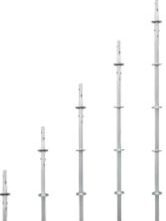
Standards: Standards are vertical poles, adjustable or fixed, made from ASTM A36 steel (50 mm diameter), and support up to 200 kg each. Galvanized couplers resist corrosion, enhancing longevity.

Ledgers: Ledgers are horizontal poles that connect standards and provide support to the working space. Available in adjustable and fixed types, they are made from galvanized steel with a maximum load capacity of 150 kg each, ensuring robust support for the scaffolding platform.
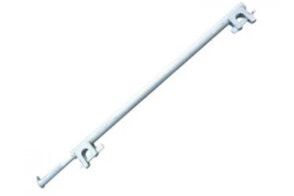
Transoms: Transoms are bearers installed on top of the ledgers at right angles, running horizontally from the back to the front. They come in single and double configurations, each measuring 2 meters in length and rated to support 100 kg per transom, defining the bay width and providing additional support to standards, boards, and planks.

Boards: Single scaffolding boards are horizontal planks that serve as a working surface. They are available in treated wood (dimensions: 50×150 mm) and steel planks (dimensions: 100×200 mm), each with a load rating of 500 kg and equipped with anti-slip coatings to ensure worker safety. They are installed throughout the scaffolding frame and offer a stable platform for workers, tools, and materials.

Braces: Braces are metallic diagonal components made of galvanized steel that prevent scaffolding from collapsing and swaying. They come in two types: X-bracing, which resists lateral forces with a 300 kg capacity, and K-bracing, which is easier to install in confined spaces.
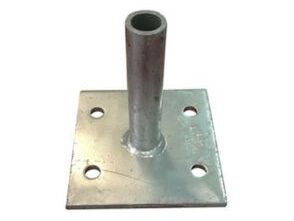
Base plates: Base plates are supporting frames placed at the base of each column. Base Plates are available in adjustable and fixed types. They measure 300×300 mm and include rubber pads and ground anchors to distribute column weight evenly and stabilize the scaffolding on various terrains. The purpose of base plates is to distribute the column weight over a great space and boost structure stability.
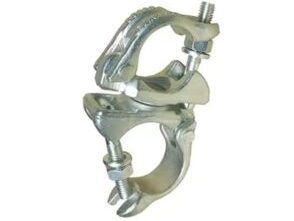
Couplers: Couplers connect poles and tubes in single scaffolding and come in two main types: swivel couplers for angular adjustments and sleeve couplers for straight connections. Swivel couplers handle up to 300 kg per connection, while sleeve couplers are rated for 500 kg. They provide flexible connections between standards and ledgers, accommodating slight misalignments without compromising structural integrity. Sleeve couplers ensure a secure fit for larger diameter poles, enhancing scaffold stability. Additionally, high-strength couplers are available for heavy-duty applications, offering enhanced compatibility with various scaffold components.

Guardrails: Guardrails are protective barriers usually placed on the outer side of scaffolding to protect workers from accidental falls. They are essential safety features of single scaffolding, especially when erected at heights. Guardrails must be installed at a minimum height of 1 meter above the working platform and are constructed from galvanized steel with 360-degree coverage to withstand impacts and provide maximum durability. Additionally, some systems include interlocking guardrail joints for added safety.
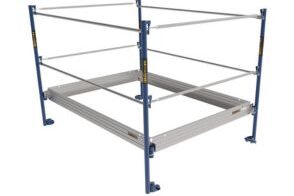
Toeboard: Toeboards are protective barriers installed on single scaffolding platforms to prevent objects and people from falling off. They are typically 100 mm in height, made from galvanized steel, and must comply with OSHA Standard 1926.451 to ensure effective containment of materials and tools.
What are The Benefits of Single Scaffolding?
There are 12 primary benefits of Single Scaffolding which are reduced labor costs, lower material expenses, streamlined design, enhanced stability, safe working platforms, accommodation of small projects, space conservation, limited ground impact, facilitated dismantling, improved access, support for brickwork, and adherence to safety standards.
1. Minimize Labor Costs: Single scaffolding reduces labor expenses by up to 30% compared to double scaffolding due to the need for less skilled labor.
2. Reduce Material Expenses: Single scaffolding uses 50% less steel and 30% fewer couplers, saving 20% on transportation and procurement costs.
3. Streamline Design: With only six main components, single scaffolding setups are 50% faster than complex systems, allowing easy assembly, disassembly, and quick adjustments.
4. Enhance Stability: Single scaffolding enhances stability by adhering to ISO 9001 standards and withstanding wind speeds up to 30 km/h, making it suitable for tasks like plastering and painting.
5. Ensure Safe Platforms: Single scaffolding ensures safe platforms through features such as guardrails, toe boards, and fully planked surfaces, which protect workers from falls and accidents.
6. Accommodate Small Projects: Its simple design makes it an ideal framework to use for small to medium-scale projects such as low-rise commercial structures, renovation, and residential spaces.
7. Conserve Space: Single scaffolding requires 30% less ground space for setup compared to double scaffolding, making it ideal for construction sites with limited space and restricted access. Low footprint framework decreases disruption in the surrounding areas.
8. Limit Ground Impact: Since single scaffolding is lightweight, exerting only 100 kg/m² of ground pressure. It reduces damage to sensitive ground projects such as asphalt, concrete, and soft soil.
9. Facilitate Dismantling: The simple dismantling process of Single Scaffolding can be completed in half the time required for double scaffolding, utilizing only two workers instead of the typical four, thereby reducing project downtime significantly. Its simple dismantling process offers a quick turnaround time
10. Improve Access: Single Scaffolding ease of accessibility boosts worker productivity by 25%, allowing tasks such as material transportation and tool retrieval to be performed more efficiently. Single scaffolding for workers is that it offers easy access to tools and workspace.
11. Support Brickwork: Single scaffolding offers a stable support surface, allowing masons to work safely at elevated heights.
12. Adhere to Safety Standards: Single scaffolding adheres to OSHA Standard 1926.451 by supporting at least four times the maximum intended load, incorporating guardrails between 0.97 and 1.14 meters above platforms, and ensuring fully planked surfaces. These measures minimize fall risks and enhance worker safety through regular inspections and mandatory safety training.
What are the Disadvantages of Single Scaffolding?
There are 10 primary disadvantages of Single scaffolding which include limited load capacity, unsuitability for heavy-duty work, reduced stability compared to double scaffolding, limited applicability in high-rise construction, instability in strong winds, frequent adjustments required for taller structures, less flexibility in complex environments, potential obstruction of surrounding areas, inability to support large equipment or materials, and limited safety features.
1. Limited Load Capacity
The main drawback of single scaffolding is its low weight-bearing capacity, limiting support for materials, tools, and personnel. Each standard in a single scaffolding setup can support up to 200 kg, while ledgers are rated to bear 150 kg, limiting its use in projects that require handling materials exceeding these capacities, such as heavy machinery or large concrete blocks. Proper load distribution is essential to maintain structural balance and prevent overloading.
2. Not Suitable for Heavy-Duty Work
Single scaffolding is unsuitable for heavy-duty tasks such as bricklaying with heavy blocks, installation of integral structural elements, and concrete pouring.
3. Less Stability Compared to Double Scaffolding
Single scaffolding is 20% less stable than double scaffolding due to a single row of vertical supports, increasing susceptibility to lateral forces and security risks in adverse weather.
4. Limited Use for High-Rise Construction
Single scaffolding is its height limitation, which makes it a less practical choice for high-rise construction. As the structure rises, the overall stability and safety of single scaffolding are compromised and require frequent adjustment. Therefore, construction managers don’t use single scaffolding for a high-rise construction project.
5. Vulnerability to Strong Winds
Single scaffolding is vulnerable to strong winds exceeding 30 km/h, which can cause instability and potential collapse, posing serious safety hazards for workers. As a result, it poses serious safety hazards for workers.
6. Frequent Adjustments for Taller Structures
Single scaffolding requires adjustments every 2 meters in taller structures, leading to frequent interruptions in workflow and potentially extending project timelines by 10-15%. These adjustments are made to the framework to ensure its stability and safety level. Frequent adjustment is a time-consuming process that, in turn, reduces productivity in the workspace.
7. Less Flexibility for Complex Work Environments
Single scaffolding struggles in environments with irregular building facades, protruding architectural elements, and confined spaces, making it unsuitable for projects like historic building restorations or complex commercial structures. If it’s used for such an environment, frequent adjustments are required. These adjustments will waste time and increase labor costs while leading to potential project completion delays.
8. Potential Obstruction of Surrounding Areas
Single scaffolding may obstruct sidewalks, vehicle ingress and egress, and emergency access routes, requiring additional planning and coordination with local authorities to mitigate disruptions. This obstruction also causes safety concerns in the surrounding areas.
9. Inability to Support Large Equipment or Materials
Due to its limited load capacity, single scaffolding can’t support large equipment or materials. If a project requires the use of heavy equipment or machinery, other types of scaffolding should be used.
10. Limited Safety Features
Single scaffolding lacks built-in safety features such as integrated safety netting and automatic lock systems, necessitating the addition of personal protective equipment (PPE) and external guardrails to enhance worker safety. To enhance worker safety, you need to integrate these structures with additional safety measures such as personal protective equipment, toe boards, or guardrails.
What’s the diagram of single scaffolding?

What is the Difference Between Single Scaffolding and Double Scaffolding?
Single scaffolding is different from double scaffolding based on various features like Support mechanism, Application, Stability, Safety, Complexity, Cost, Erection Difficulty, Installation Time, Height, and Strength.
Here is a table that describes the main points of difference between single scaffolding and double scaffolding.
| Single Scaffolding | Double Scaffolding |
| Framework needs wall support as there is a single row of poles. | Doesn’t need wall support as double vertical poles offer self-support |
| Mainly used for brick masonry. Up to 200 kg per standard | More safer and has integrated safety netting, automatic lock systems |
| Less stable as single row structure. Limited adaptability to uneven terrains and strong winds | More stable as double row structure. Better adaptability with enhanced stabilization features |
| Less safe, Basic guardrails and toe boards | The framework needs wall support as there is a single row of poles. |
| Suitable for short projects | A complex structure comprises multiple components and parts. |
| Cost-effective, less material and labor required | Higher cost due to increased materials and labor complexity |
| Easier to erect | Difficult to erect |
| Faster installation, typically half the time | Slower installation nearly double, requiring more time due to complexity |
| Low strength, suitable for lightweight task | High strength, suitable for complex tasks |
| Suitable for buildings up to 10 stories | Suitable for high-rise buildings, exceeding 10 stories |
Support Mechanism: Single scaffolding requires wall support with a single row of vertical poles (standards) and is primarily used for masonry work. Double scaffolding is self-supporting with double vertical poles. Double scaffolding is suitable for stonework and heavy-duty tasks without wall support.
Stability and Safety: Single scaffolding is unstable in winds over 30 km/h and has limited safety features. In contrast, double scaffolding withstands winds up to 60 km/h and includes integrated access ladders, safety netting, and automatic locking guardrails, complying with ISO 45001 safety standards. While both types adhere to OSHA guidelines, double scaffolding often requires additional safety certifications due to its complexity and higher load capacity. Safety netting and anchor points can be added to single scaffolding for enhanced protection.
Structure and Cost: Single scaffolding has a simple structure with a single row of standards, ledgers, and putlogs, costing approximately 25% less than double scaffolding due to fewer materials and reduced labor from simpler assembly. Double scaffolding is more complex, requiring additional materials and resources.
Installation Time and Load Capacity: Single scaffolding can be erected in half the time of double scaffolding, typically 3 hours with two workers versus 6 hours with four workers. Double scaffolding offers a more robust framework, supporting up to 500 kg per standard using ASTM A572 Grade 50 steel through dual vertical supports and enhanced load distribution. Single scaffolding has a limited load-bearing capacity, supporting fewer tools, materials, and personnel.
Project Suitability: Single scaffolding is ideal for small to medium-height projects, offering cost-effectiveness and quick installation. Double scaffolding is suitable for high-rise buildings and outdoor projects with variable weather conditions, providing enhanced stability against strong winds up to 60 km/h and heavy rains through anchoring systems and weather-resistant materials.






